Beef Industry of Australia
VerifiedAdded on 2023/01/23
|14
|4153
|87
AI Summary
This article provides an analysis of the beef industry in Australia, including its current economic prospects, opportunities for future innovation, and system weaknesses. It discusses the firms, knowledge base, and institutions involved in the industry.
Contribute Materials
Your contribution can guide someone’s learning journey. Share your
documents today.
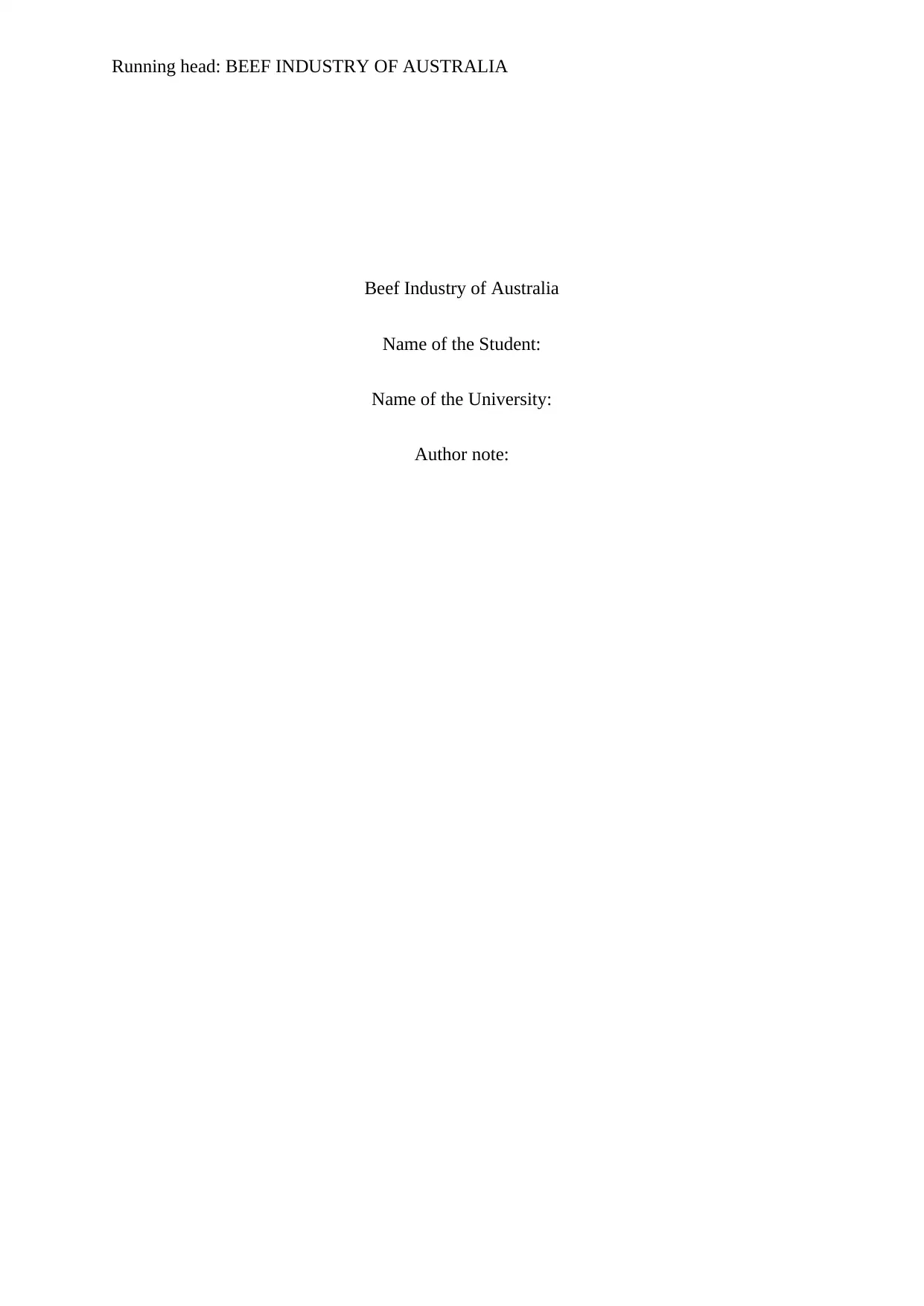
Running head: BEEF INDUSTRY OF AUSTRALIA
Beef Industry of Australia
Name of the Student:
Name of the University:
Author note:
Beef Industry of Australia
Name of the Student:
Name of the University:
Author note:
Secure Best Marks with AI Grader
Need help grading? Try our AI Grader for instant feedback on your assignments.

1BEEF INDUSTRY OF AUSTRALIA
Table of Contents
1. Introduction............................................................................................................................2
2. Discussion..............................................................................................................................2
2.1. Current economic prospects (growth or decline over past five years)............................2
2.2. Opportunities for future innovation................................................................................3
2.3. SSI...................................................................................................................................4
2.3.1. Firms........................................................................................................................4
2.3.2. Knowledge Base.......................................................................................................6
2.3.3. Institutions................................................................................................................7
2.4. Top three system weaknesses or failure..........................................................................9
2.5. Addressing the system failure of factory style livestock production..............................9
3. Conclusion............................................................................................................................10
4. References:...........................................................................................................................11
Table of Contents
1. Introduction............................................................................................................................2
2. Discussion..............................................................................................................................2
2.1. Current economic prospects (growth or decline over past five years)............................2
2.2. Opportunities for future innovation................................................................................3
2.3. SSI...................................................................................................................................4
2.3.1. Firms........................................................................................................................4
2.3.2. Knowledge Base.......................................................................................................6
2.3.3. Institutions................................................................................................................7
2.4. Top three system weaknesses or failure..........................................................................9
2.5. Addressing the system failure of factory style livestock production..............................9
3. Conclusion............................................................................................................................10
4. References:...........................................................................................................................11
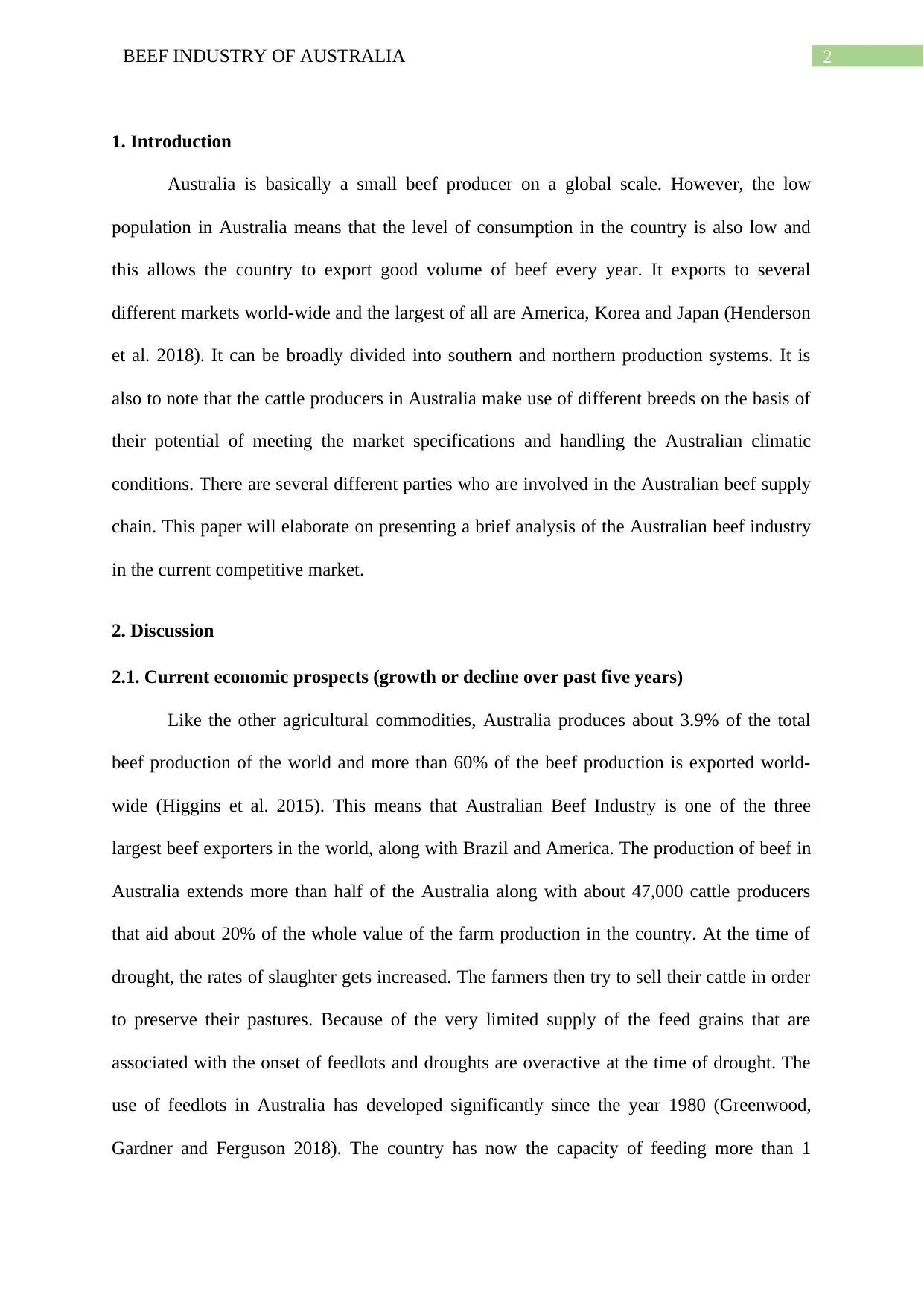
2BEEF INDUSTRY OF AUSTRALIA
1. Introduction
Australia is basically a small beef producer on a global scale. However, the low
population in Australia means that the level of consumption in the country is also low and
this allows the country to export good volume of beef every year. It exports to several
different markets world-wide and the largest of all are America, Korea and Japan (Henderson
et al. 2018). It can be broadly divided into southern and northern production systems. It is
also to note that the cattle producers in Australia make use of different breeds on the basis of
their potential of meeting the market specifications and handling the Australian climatic
conditions. There are several different parties who are involved in the Australian beef supply
chain. This paper will elaborate on presenting a brief analysis of the Australian beef industry
in the current competitive market.
2. Discussion
2.1. Current economic prospects (growth or decline over past five years)
Like the other agricultural commodities, Australia produces about 3.9% of the total
beef production of the world and more than 60% of the beef production is exported world-
wide (Higgins et al. 2015). This means that Australian Beef Industry is one of the three
largest beef exporters in the world, along with Brazil and America. The production of beef in
Australia extends more than half of the Australia along with about 47,000 cattle producers
that aid about 20% of the whole value of the farm production in the country. At the time of
drought, the rates of slaughter gets increased. The farmers then try to sell their cattle in order
to preserve their pastures. Because of the very limited supply of the feed grains that are
associated with the onset of feedlots and droughts are overactive at the time of drought. The
use of feedlots in Australia has developed significantly since the year 1980 (Greenwood,
Gardner and Ferguson 2018). The country has now the capacity of feeding more than 1
1. Introduction
Australia is basically a small beef producer on a global scale. However, the low
population in Australia means that the level of consumption in the country is also low and
this allows the country to export good volume of beef every year. It exports to several
different markets world-wide and the largest of all are America, Korea and Japan (Henderson
et al. 2018). It can be broadly divided into southern and northern production systems. It is
also to note that the cattle producers in Australia make use of different breeds on the basis of
their potential of meeting the market specifications and handling the Australian climatic
conditions. There are several different parties who are involved in the Australian beef supply
chain. This paper will elaborate on presenting a brief analysis of the Australian beef industry
in the current competitive market.
2. Discussion
2.1. Current economic prospects (growth or decline over past five years)
Like the other agricultural commodities, Australia produces about 3.9% of the total
beef production of the world and more than 60% of the beef production is exported world-
wide (Higgins et al. 2015). This means that Australian Beef Industry is one of the three
largest beef exporters in the world, along with Brazil and America. The production of beef in
Australia extends more than half of the Australia along with about 47,000 cattle producers
that aid about 20% of the whole value of the farm production in the country. At the time of
drought, the rates of slaughter gets increased. The farmers then try to sell their cattle in order
to preserve their pastures. Because of the very limited supply of the feed grains that are
associated with the onset of feedlots and droughts are overactive at the time of drought. The
use of feedlots in Australia has developed significantly since the year 1980 (Greenwood,
Gardner and Ferguson 2018). The country has now the capacity of feeding more than 1
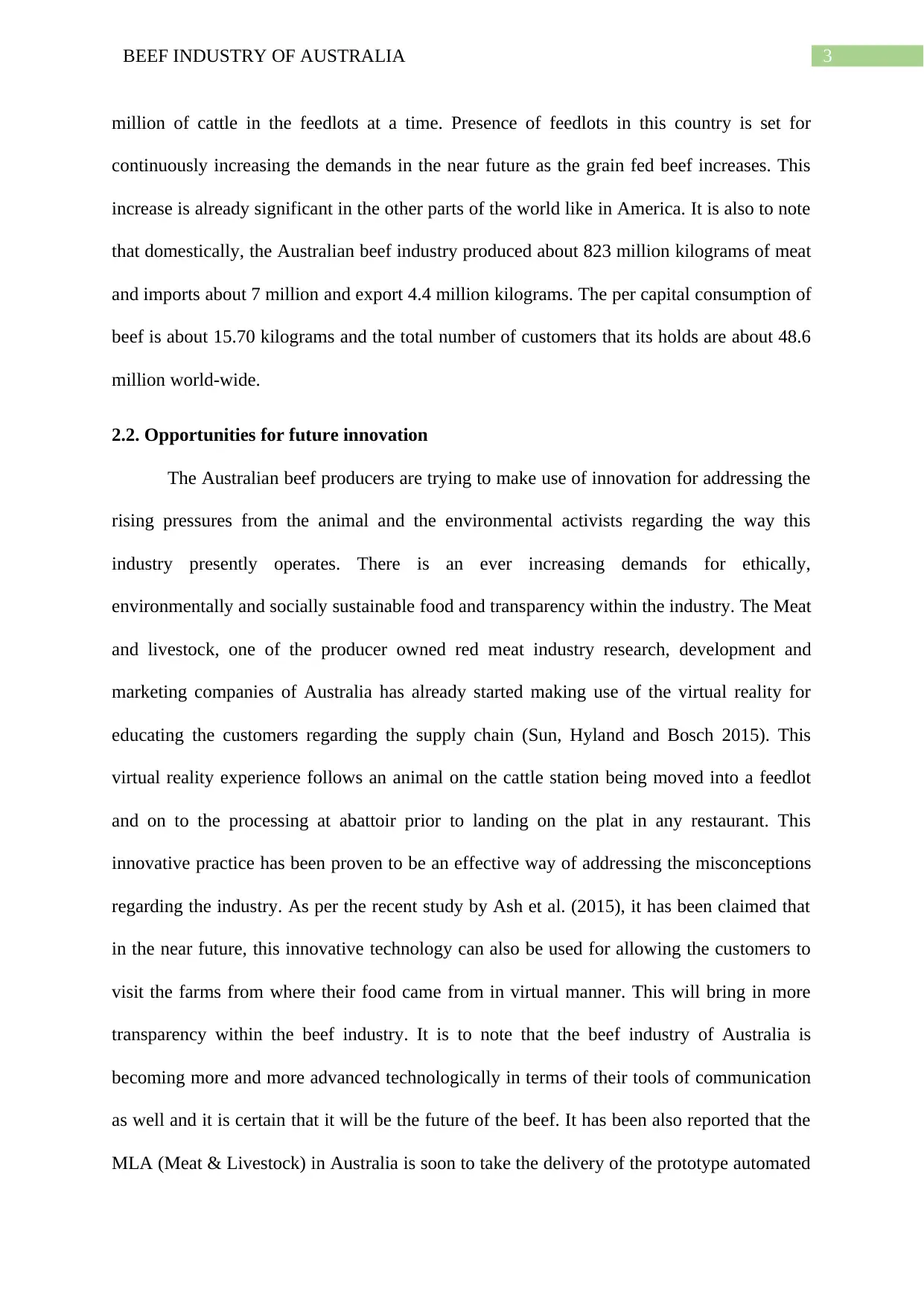
3BEEF INDUSTRY OF AUSTRALIA
million of cattle in the feedlots at a time. Presence of feedlots in this country is set for
continuously increasing the demands in the near future as the grain fed beef increases. This
increase is already significant in the other parts of the world like in America. It is also to note
that domestically, the Australian beef industry produced about 823 million kilograms of meat
and imports about 7 million and export 4.4 million kilograms. The per capital consumption of
beef is about 15.70 kilograms and the total number of customers that its holds are about 48.6
million world-wide.
2.2. Opportunities for future innovation
The Australian beef producers are trying to make use of innovation for addressing the
rising pressures from the animal and the environmental activists regarding the way this
industry presently operates. There is an ever increasing demands for ethically,
environmentally and socially sustainable food and transparency within the industry. The Meat
and livestock, one of the producer owned red meat industry research, development and
marketing companies of Australia has already started making use of the virtual reality for
educating the customers regarding the supply chain (Sun, Hyland and Bosch 2015). This
virtual reality experience follows an animal on the cattle station being moved into a feedlot
and on to the processing at abattoir prior to landing on the plat in any restaurant. This
innovative practice has been proven to be an effective way of addressing the misconceptions
regarding the industry. As per the recent study by Ash et al. (2015), it has been claimed that
in the near future, this innovative technology can also be used for allowing the customers to
visit the farms from where their food came from in virtual manner. This will bring in more
transparency within the beef industry. It is to note that the beef industry of Australia is
becoming more and more advanced technologically in terms of their tools of communication
as well and it is certain that it will be the future of the beef. It has been also reported that the
MLA (Meat & Livestock) in Australia is soon to take the delivery of the prototype automated
million of cattle in the feedlots at a time. Presence of feedlots in this country is set for
continuously increasing the demands in the near future as the grain fed beef increases. This
increase is already significant in the other parts of the world like in America. It is also to note
that domestically, the Australian beef industry produced about 823 million kilograms of meat
and imports about 7 million and export 4.4 million kilograms. The per capital consumption of
beef is about 15.70 kilograms and the total number of customers that its holds are about 48.6
million world-wide.
2.2. Opportunities for future innovation
The Australian beef producers are trying to make use of innovation for addressing the
rising pressures from the animal and the environmental activists regarding the way this
industry presently operates. There is an ever increasing demands for ethically,
environmentally and socially sustainable food and transparency within the industry. The Meat
and livestock, one of the producer owned red meat industry research, development and
marketing companies of Australia has already started making use of the virtual reality for
educating the customers regarding the supply chain (Sun, Hyland and Bosch 2015). This
virtual reality experience follows an animal on the cattle station being moved into a feedlot
and on to the processing at abattoir prior to landing on the plat in any restaurant. This
innovative practice has been proven to be an effective way of addressing the misconceptions
regarding the industry. As per the recent study by Ash et al. (2015), it has been claimed that
in the near future, this innovative technology can also be used for allowing the customers to
visit the farms from where their food came from in virtual manner. This will bring in more
transparency within the beef industry. It is to note that the beef industry of Australia is
becoming more and more advanced technologically in terms of their tools of communication
as well and it is certain that it will be the future of the beef. It has been also reported that the
MLA (Meat & Livestock) in Australia is soon to take the delivery of the prototype automated
Secure Best Marks with AI Grader
Need help grading? Try our AI Grader for instant feedback on your assignments.
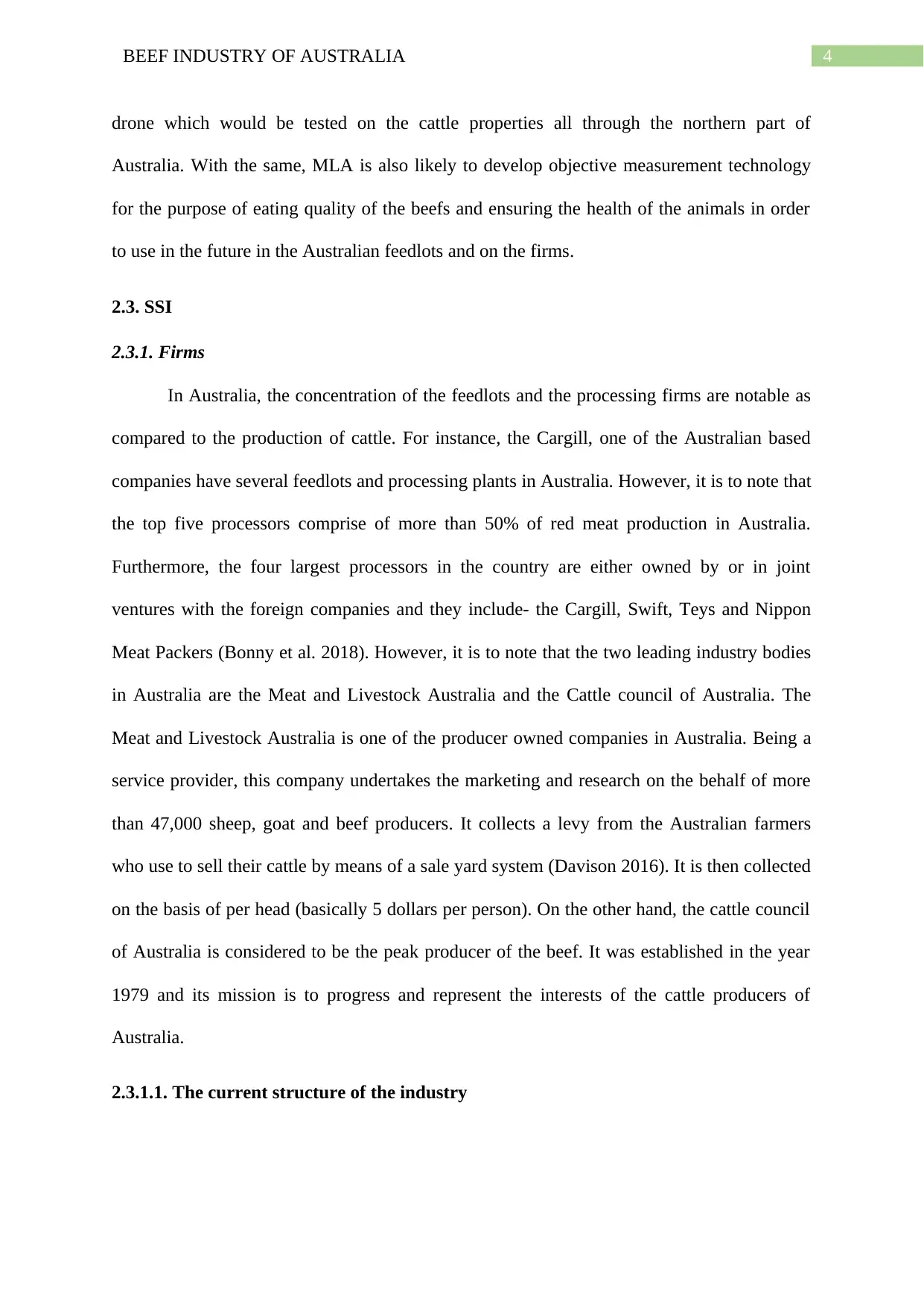
4BEEF INDUSTRY OF AUSTRALIA
drone which would be tested on the cattle properties all through the northern part of
Australia. With the same, MLA is also likely to develop objective measurement technology
for the purpose of eating quality of the beefs and ensuring the health of the animals in order
to use in the future in the Australian feedlots and on the firms.
2.3. SSI
2.3.1. Firms
In Australia, the concentration of the feedlots and the processing firms are notable as
compared to the production of cattle. For instance, the Cargill, one of the Australian based
companies have several feedlots and processing plants in Australia. However, it is to note that
the top five processors comprise of more than 50% of red meat production in Australia.
Furthermore, the four largest processors in the country are either owned by or in joint
ventures with the foreign companies and they include- the Cargill, Swift, Teys and Nippon
Meat Packers (Bonny et al. 2018). However, it is to note that the two leading industry bodies
in Australia are the Meat and Livestock Australia and the Cattle council of Australia. The
Meat and Livestock Australia is one of the producer owned companies in Australia. Being a
service provider, this company undertakes the marketing and research on the behalf of more
than 47,000 sheep, goat and beef producers. It collects a levy from the Australian farmers
who use to sell their cattle by means of a sale yard system (Davison 2016). It is then collected
on the basis of per head (basically 5 dollars per person). On the other hand, the cattle council
of Australia is considered to be the peak producer of the beef. It was established in the year
1979 and its mission is to progress and represent the interests of the cattle producers of
Australia.
2.3.1.1. The current structure of the industry
drone which would be tested on the cattle properties all through the northern part of
Australia. With the same, MLA is also likely to develop objective measurement technology
for the purpose of eating quality of the beefs and ensuring the health of the animals in order
to use in the future in the Australian feedlots and on the firms.
2.3. SSI
2.3.1. Firms
In Australia, the concentration of the feedlots and the processing firms are notable as
compared to the production of cattle. For instance, the Cargill, one of the Australian based
companies have several feedlots and processing plants in Australia. However, it is to note that
the top five processors comprise of more than 50% of red meat production in Australia.
Furthermore, the four largest processors in the country are either owned by or in joint
ventures with the foreign companies and they include- the Cargill, Swift, Teys and Nippon
Meat Packers (Bonny et al. 2018). However, it is to note that the two leading industry bodies
in Australia are the Meat and Livestock Australia and the Cattle council of Australia. The
Meat and Livestock Australia is one of the producer owned companies in Australia. Being a
service provider, this company undertakes the marketing and research on the behalf of more
than 47,000 sheep, goat and beef producers. It collects a levy from the Australian farmers
who use to sell their cattle by means of a sale yard system (Davison 2016). It is then collected
on the basis of per head (basically 5 dollars per person). On the other hand, the cattle council
of Australia is considered to be the peak producer of the beef. It was established in the year
1979 and its mission is to progress and represent the interests of the cattle producers of
Australia.
2.3.1.1. The current structure of the industry
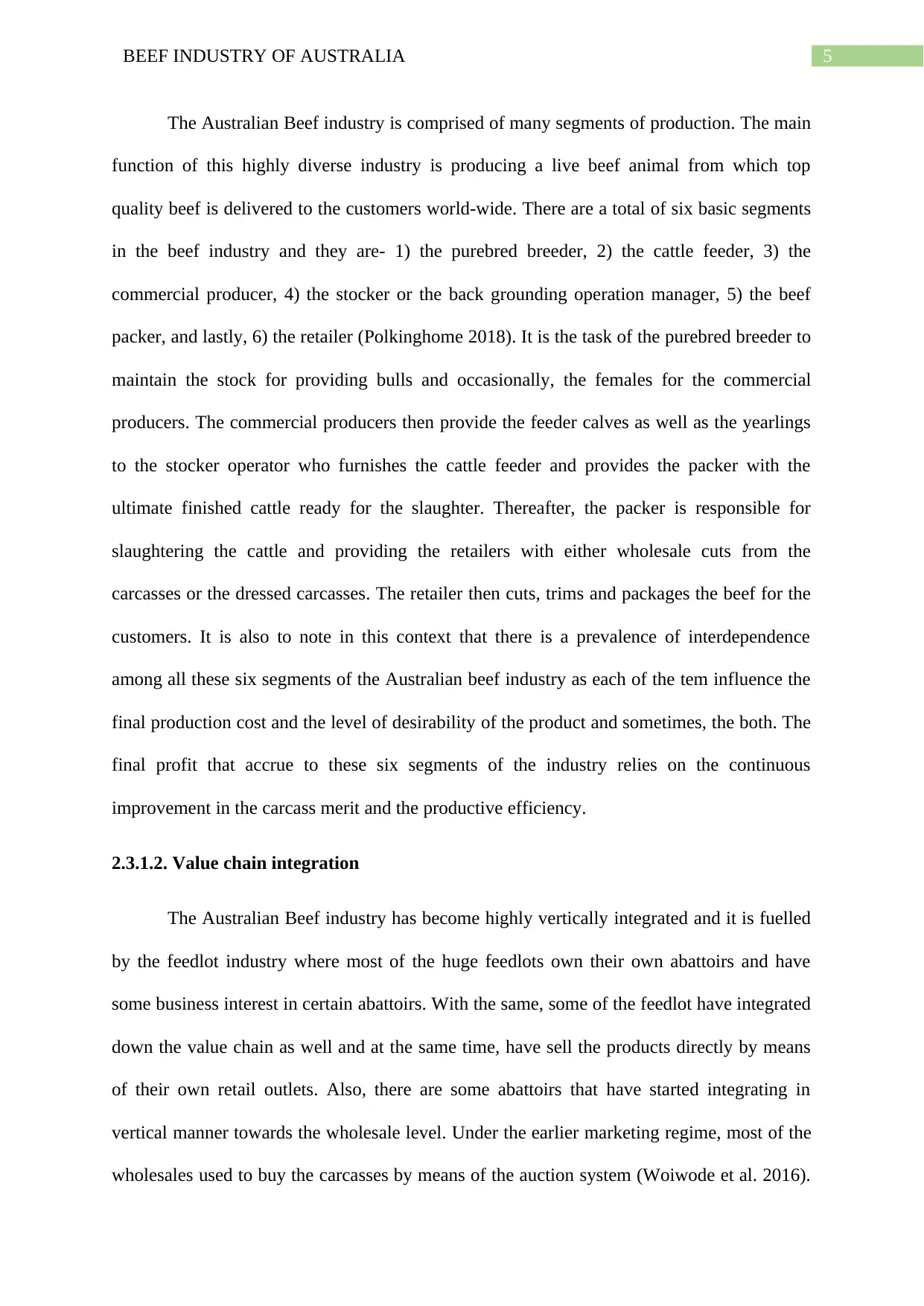
5BEEF INDUSTRY OF AUSTRALIA
The Australian Beef industry is comprised of many segments of production. The main
function of this highly diverse industry is producing a live beef animal from which top
quality beef is delivered to the customers world-wide. There are a total of six basic segments
in the beef industry and they are- 1) the purebred breeder, 2) the cattle feeder, 3) the
commercial producer, 4) the stocker or the back grounding operation manager, 5) the beef
packer, and lastly, 6) the retailer (Polkinghome 2018). It is the task of the purebred breeder to
maintain the stock for providing bulls and occasionally, the females for the commercial
producers. The commercial producers then provide the feeder calves as well as the yearlings
to the stocker operator who furnishes the cattle feeder and provides the packer with the
ultimate finished cattle ready for the slaughter. Thereafter, the packer is responsible for
slaughtering the cattle and providing the retailers with either wholesale cuts from the
carcasses or the dressed carcasses. The retailer then cuts, trims and packages the beef for the
customers. It is also to note in this context that there is a prevalence of interdependence
among all these six segments of the Australian beef industry as each of the tem influence the
final production cost and the level of desirability of the product and sometimes, the both. The
final profit that accrue to these six segments of the industry relies on the continuous
improvement in the carcass merit and the productive efficiency.
2.3.1.2. Value chain integration
The Australian Beef industry has become highly vertically integrated and it is fuelled
by the feedlot industry where most of the huge feedlots own their own abattoirs and have
some business interest in certain abattoirs. With the same, some of the feedlot have integrated
down the value chain as well and at the same time, have sell the products directly by means
of their own retail outlets. Also, there are some abattoirs that have started integrating in
vertical manner towards the wholesale level. Under the earlier marketing regime, most of the
wholesales used to buy the carcasses by means of the auction system (Woiwode et al. 2016).
The Australian Beef industry is comprised of many segments of production. The main
function of this highly diverse industry is producing a live beef animal from which top
quality beef is delivered to the customers world-wide. There are a total of six basic segments
in the beef industry and they are- 1) the purebred breeder, 2) the cattle feeder, 3) the
commercial producer, 4) the stocker or the back grounding operation manager, 5) the beef
packer, and lastly, 6) the retailer (Polkinghome 2018). It is the task of the purebred breeder to
maintain the stock for providing bulls and occasionally, the females for the commercial
producers. The commercial producers then provide the feeder calves as well as the yearlings
to the stocker operator who furnishes the cattle feeder and provides the packer with the
ultimate finished cattle ready for the slaughter. Thereafter, the packer is responsible for
slaughtering the cattle and providing the retailers with either wholesale cuts from the
carcasses or the dressed carcasses. The retailer then cuts, trims and packages the beef for the
customers. It is also to note in this context that there is a prevalence of interdependence
among all these six segments of the Australian beef industry as each of the tem influence the
final production cost and the level of desirability of the product and sometimes, the both. The
final profit that accrue to these six segments of the industry relies on the continuous
improvement in the carcass merit and the productive efficiency.
2.3.1.2. Value chain integration
The Australian Beef industry has become highly vertically integrated and it is fuelled
by the feedlot industry where most of the huge feedlots own their own abattoirs and have
some business interest in certain abattoirs. With the same, some of the feedlot have integrated
down the value chain as well and at the same time, have sell the products directly by means
of their own retail outlets. Also, there are some abattoirs that have started integrating in
vertical manner towards the wholesale level. Under the earlier marketing regime, most of the
wholesales used to buy the carcasses by means of the auction system (Woiwode et al. 2016).

6BEEF INDUSTRY OF AUSTRALIA
At present, there are several wholesalers source that live the slaughter animals directly from
the feedlots and farmers on a bid and the offer basis. This means that they take the ownership
of the animal right before the animals are slaughtered. These animals are then slaughtered at
an abattoir of the choice of the wholesaler, where after the carcass is distributed to the
retailers of beef. In some of the cases, the public are also permitted to buy the carcasses
directly from the wholesalers.
2.3.1.3. Level of innovation in the sector
Australia prides itself for being able to produce superior quality and diseases free
beef. The Australian beef industry is continuously researching for different ways for
improving the efficiencies of its production. It has led the industry to maintain a strong
profitability in the situations where the input prices are being increased day by day. It is also
to mention that the future of the Australian beef industry is assisted by the fact that the
country has a world-wide reputation of producing and supplying high quality beef that are
disease free. It is to note that the price of LED lightings in Australia has recently reduced by
about 90% in Australia and with the same, the product lifespan has also been doubled
(Goddard et al. 2016). This in turn has significantly improved the viability of the indoor
farming which depends highly on the artificial lighting. With the same, the bioengineered
products such as eggs and milk are now produced in the laboratories for the ensuring the
standards that meet the needs of the biggest industrial caterers and the manufacturers of food
who buy the eggs and milk of thousands litres and thousands kilograms.
2.3.2. Knowledge Base
2.3.2.1. Technology applications in the sector
Technology is changing the Australian beef industry faster than ever before. The Meat
and livestock, one of the producer owned red meat industry research, development and
At present, there are several wholesalers source that live the slaughter animals directly from
the feedlots and farmers on a bid and the offer basis. This means that they take the ownership
of the animal right before the animals are slaughtered. These animals are then slaughtered at
an abattoir of the choice of the wholesaler, where after the carcass is distributed to the
retailers of beef. In some of the cases, the public are also permitted to buy the carcasses
directly from the wholesalers.
2.3.1.3. Level of innovation in the sector
Australia prides itself for being able to produce superior quality and diseases free
beef. The Australian beef industry is continuously researching for different ways for
improving the efficiencies of its production. It has led the industry to maintain a strong
profitability in the situations where the input prices are being increased day by day. It is also
to mention that the future of the Australian beef industry is assisted by the fact that the
country has a world-wide reputation of producing and supplying high quality beef that are
disease free. It is to note that the price of LED lightings in Australia has recently reduced by
about 90% in Australia and with the same, the product lifespan has also been doubled
(Goddard et al. 2016). This in turn has significantly improved the viability of the indoor
farming which depends highly on the artificial lighting. With the same, the bioengineered
products such as eggs and milk are now produced in the laboratories for the ensuring the
standards that meet the needs of the biggest industrial caterers and the manufacturers of food
who buy the eggs and milk of thousands litres and thousands kilograms.
2.3.2. Knowledge Base
2.3.2.1. Technology applications in the sector
Technology is changing the Australian beef industry faster than ever before. The Meat
and livestock, one of the producer owned red meat industry research, development and
Paraphrase This Document
Need a fresh take? Get an instant paraphrase of this document with our AI Paraphraser
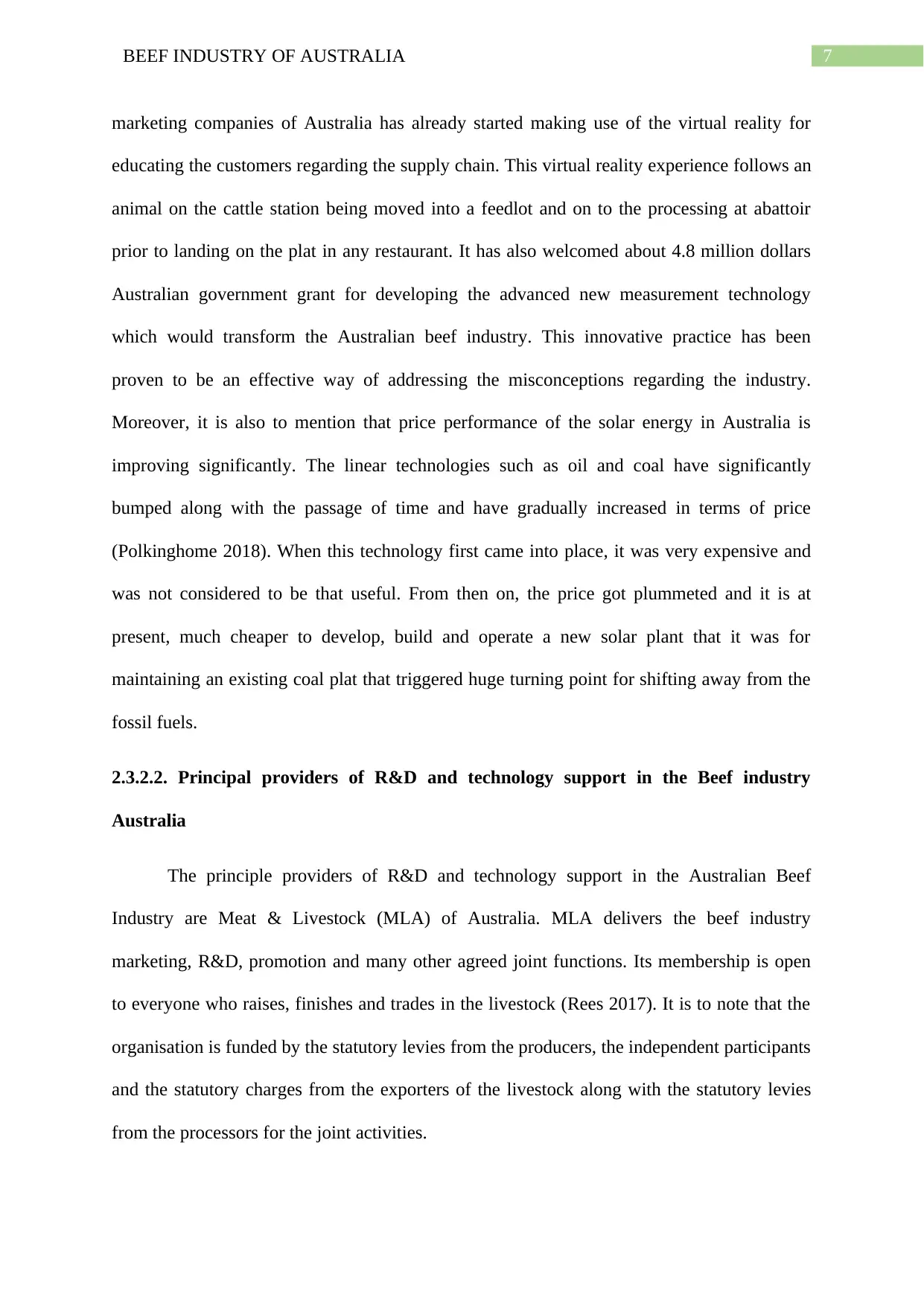
7BEEF INDUSTRY OF AUSTRALIA
marketing companies of Australia has already started making use of the virtual reality for
educating the customers regarding the supply chain. This virtual reality experience follows an
animal on the cattle station being moved into a feedlot and on to the processing at abattoir
prior to landing on the plat in any restaurant. It has also welcomed about 4.8 million dollars
Australian government grant for developing the advanced new measurement technology
which would transform the Australian beef industry. This innovative practice has been
proven to be an effective way of addressing the misconceptions regarding the industry.
Moreover, it is also to mention that price performance of the solar energy in Australia is
improving significantly. The linear technologies such as oil and coal have significantly
bumped along with the passage of time and have gradually increased in terms of price
(Polkinghome 2018). When this technology first came into place, it was very expensive and
was not considered to be that useful. From then on, the price got plummeted and it is at
present, much cheaper to develop, build and operate a new solar plant that it was for
maintaining an existing coal plat that triggered huge turning point for shifting away from the
fossil fuels.
2.3.2.2. Principal providers of R&D and technology support in the Beef industry
Australia
The principle providers of R&D and technology support in the Australian Beef
Industry are Meat & Livestock (MLA) of Australia. MLA delivers the beef industry
marketing, R&D, promotion and many other agreed joint functions. Its membership is open
to everyone who raises, finishes and trades in the livestock (Rees 2017). It is to note that the
organisation is funded by the statutory levies from the producers, the independent participants
and the statutory charges from the exporters of the livestock along with the statutory levies
from the processors for the joint activities.
marketing companies of Australia has already started making use of the virtual reality for
educating the customers regarding the supply chain. This virtual reality experience follows an
animal on the cattle station being moved into a feedlot and on to the processing at abattoir
prior to landing on the plat in any restaurant. It has also welcomed about 4.8 million dollars
Australian government grant for developing the advanced new measurement technology
which would transform the Australian beef industry. This innovative practice has been
proven to be an effective way of addressing the misconceptions regarding the industry.
Moreover, it is also to mention that price performance of the solar energy in Australia is
improving significantly. The linear technologies such as oil and coal have significantly
bumped along with the passage of time and have gradually increased in terms of price
(Polkinghome 2018). When this technology first came into place, it was very expensive and
was not considered to be that useful. From then on, the price got plummeted and it is at
present, much cheaper to develop, build and operate a new solar plant that it was for
maintaining an existing coal plat that triggered huge turning point for shifting away from the
fossil fuels.
2.3.2.2. Principal providers of R&D and technology support in the Beef industry
Australia
The principle providers of R&D and technology support in the Australian Beef
Industry are Meat & Livestock (MLA) of Australia. MLA delivers the beef industry
marketing, R&D, promotion and many other agreed joint functions. Its membership is open
to everyone who raises, finishes and trades in the livestock (Rees 2017). It is to note that the
organisation is funded by the statutory levies from the producers, the independent participants
and the statutory charges from the exporters of the livestock along with the statutory levies
from the processors for the joint activities.
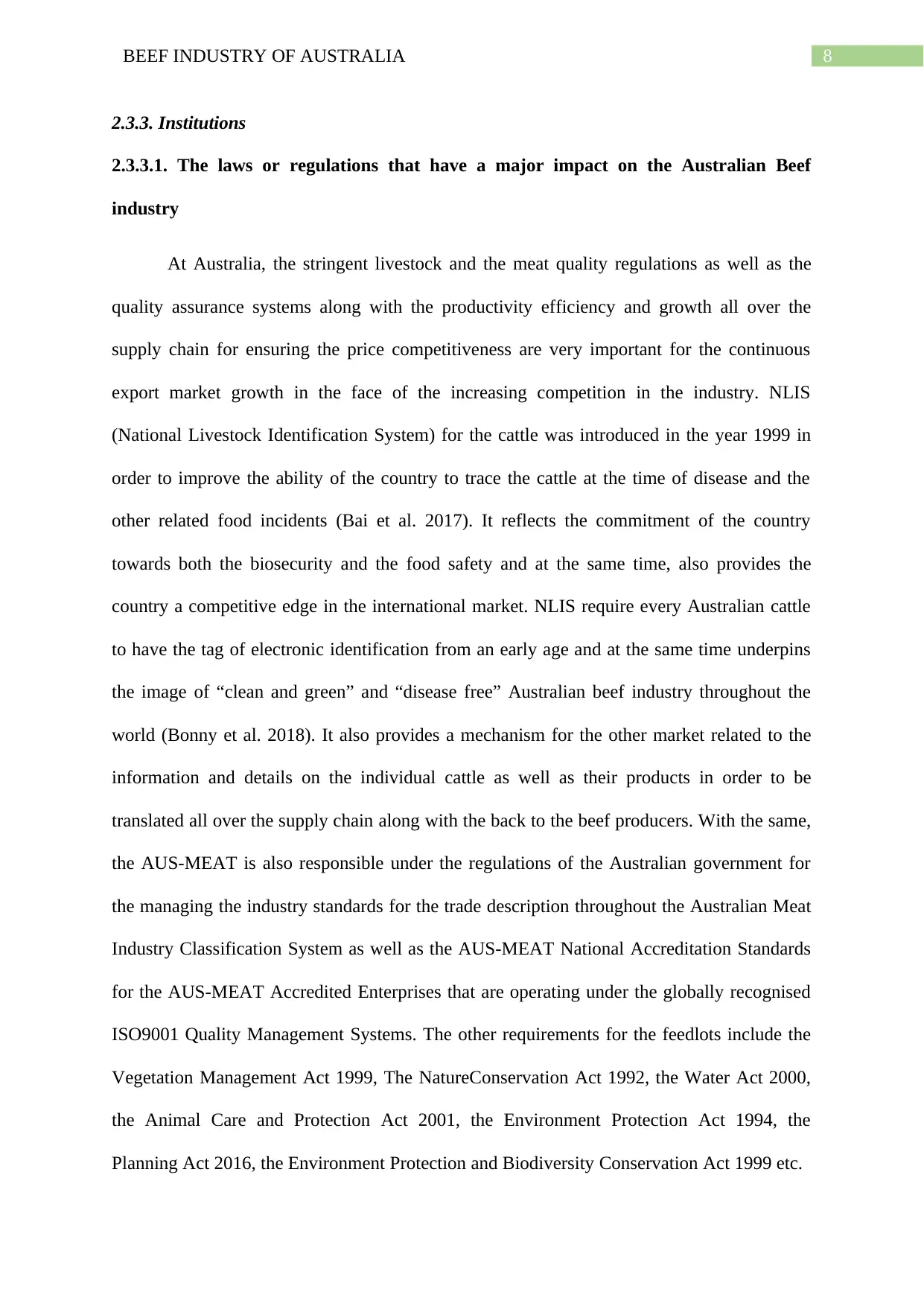
8BEEF INDUSTRY OF AUSTRALIA
2.3.3. Institutions
2.3.3.1. The laws or regulations that have a major impact on the Australian Beef
industry
At Australia, the stringent livestock and the meat quality regulations as well as the
quality assurance systems along with the productivity efficiency and growth all over the
supply chain for ensuring the price competitiveness are very important for the continuous
export market growth in the face of the increasing competition in the industry. NLIS
(National Livestock Identification System) for the cattle was introduced in the year 1999 in
order to improve the ability of the country to trace the cattle at the time of disease and the
other related food incidents (Bai et al. 2017). It reflects the commitment of the country
towards both the biosecurity and the food safety and at the same time, also provides the
country a competitive edge in the international market. NLIS require every Australian cattle
to have the tag of electronic identification from an early age and at the same time underpins
the image of “clean and green” and “disease free” Australian beef industry throughout the
world (Bonny et al. 2018). It also provides a mechanism for the other market related to the
information and details on the individual cattle as well as their products in order to be
translated all over the supply chain along with the back to the beef producers. With the same,
the AUS-MEAT is also responsible under the regulations of the Australian government for
the managing the industry standards for the trade description throughout the Australian Meat
Industry Classification System as well as the AUS-MEAT National Accreditation Standards
for the AUS-MEAT Accredited Enterprises that are operating under the globally recognised
ISO9001 Quality Management Systems. The other requirements for the feedlots include the
Vegetation Management Act 1999, The NatureConservation Act 1992, the Water Act 2000,
the Animal Care and Protection Act 2001, the Environment Protection Act 1994, the
Planning Act 2016, the Environment Protection and Biodiversity Conservation Act 1999 etc.
2.3.3. Institutions
2.3.3.1. The laws or regulations that have a major impact on the Australian Beef
industry
At Australia, the stringent livestock and the meat quality regulations as well as the
quality assurance systems along with the productivity efficiency and growth all over the
supply chain for ensuring the price competitiveness are very important for the continuous
export market growth in the face of the increasing competition in the industry. NLIS
(National Livestock Identification System) for the cattle was introduced in the year 1999 in
order to improve the ability of the country to trace the cattle at the time of disease and the
other related food incidents (Bai et al. 2017). It reflects the commitment of the country
towards both the biosecurity and the food safety and at the same time, also provides the
country a competitive edge in the international market. NLIS require every Australian cattle
to have the tag of electronic identification from an early age and at the same time underpins
the image of “clean and green” and “disease free” Australian beef industry throughout the
world (Bonny et al. 2018). It also provides a mechanism for the other market related to the
information and details on the individual cattle as well as their products in order to be
translated all over the supply chain along with the back to the beef producers. With the same,
the AUS-MEAT is also responsible under the regulations of the Australian government for
the managing the industry standards for the trade description throughout the Australian Meat
Industry Classification System as well as the AUS-MEAT National Accreditation Standards
for the AUS-MEAT Accredited Enterprises that are operating under the globally recognised
ISO9001 Quality Management Systems. The other requirements for the feedlots include the
Vegetation Management Act 1999, The NatureConservation Act 1992, the Water Act 2000,
the Animal Care and Protection Act 2001, the Environment Protection Act 1994, the
Planning Act 2016, the Environment Protection and Biodiversity Conservation Act 1999 etc.
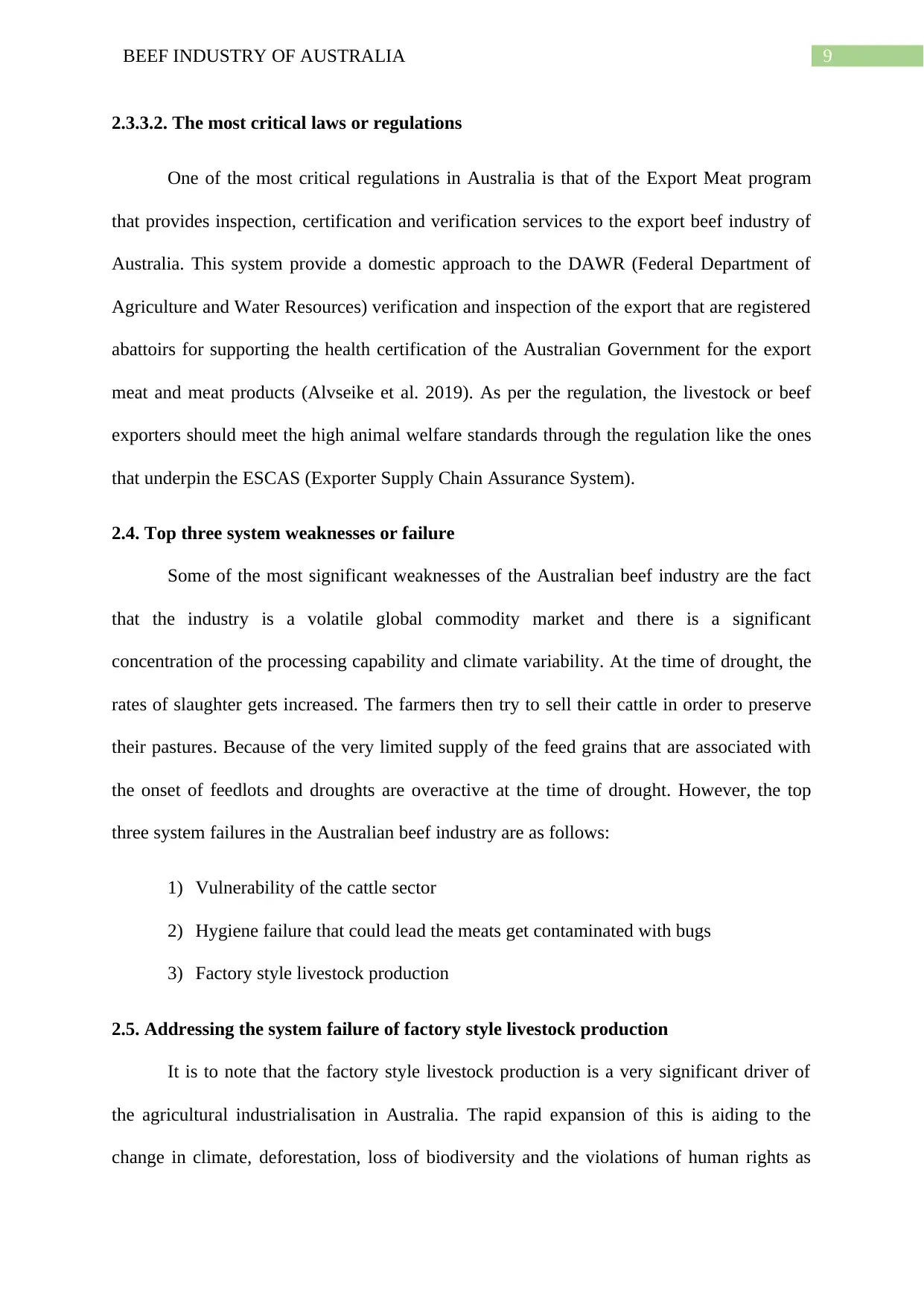
9BEEF INDUSTRY OF AUSTRALIA
2.3.3.2. The most critical laws or regulations
One of the most critical regulations in Australia is that of the Export Meat program
that provides inspection, certification and verification services to the export beef industry of
Australia. This system provide a domestic approach to the DAWR (Federal Department of
Agriculture and Water Resources) verification and inspection of the export that are registered
abattoirs for supporting the health certification of the Australian Government for the export
meat and meat products (Alvseike et al. 2019). As per the regulation, the livestock or beef
exporters should meet the high animal welfare standards through the regulation like the ones
that underpin the ESCAS (Exporter Supply Chain Assurance System).
2.4. Top three system weaknesses or failure
Some of the most significant weaknesses of the Australian beef industry are the fact
that the industry is a volatile global commodity market and there is a significant
concentration of the processing capability and climate variability. At the time of drought, the
rates of slaughter gets increased. The farmers then try to sell their cattle in order to preserve
their pastures. Because of the very limited supply of the feed grains that are associated with
the onset of feedlots and droughts are overactive at the time of drought. However, the top
three system failures in the Australian beef industry are as follows:
1) Vulnerability of the cattle sector
2) Hygiene failure that could lead the meats get contaminated with bugs
3) Factory style livestock production
2.5. Addressing the system failure of factory style livestock production
It is to note that the factory style livestock production is a very significant driver of
the agricultural industrialisation in Australia. The rapid expansion of this is aiding to the
change in climate, deforestation, loss of biodiversity and the violations of human rights as
2.3.3.2. The most critical laws or regulations
One of the most critical regulations in Australia is that of the Export Meat program
that provides inspection, certification and verification services to the export beef industry of
Australia. This system provide a domestic approach to the DAWR (Federal Department of
Agriculture and Water Resources) verification and inspection of the export that are registered
abattoirs for supporting the health certification of the Australian Government for the export
meat and meat products (Alvseike et al. 2019). As per the regulation, the livestock or beef
exporters should meet the high animal welfare standards through the regulation like the ones
that underpin the ESCAS (Exporter Supply Chain Assurance System).
2.4. Top three system weaknesses or failure
Some of the most significant weaknesses of the Australian beef industry are the fact
that the industry is a volatile global commodity market and there is a significant
concentration of the processing capability and climate variability. At the time of drought, the
rates of slaughter gets increased. The farmers then try to sell their cattle in order to preserve
their pastures. Because of the very limited supply of the feed grains that are associated with
the onset of feedlots and droughts are overactive at the time of drought. However, the top
three system failures in the Australian beef industry are as follows:
1) Vulnerability of the cattle sector
2) Hygiene failure that could lead the meats get contaminated with bugs
3) Factory style livestock production
2.5. Addressing the system failure of factory style livestock production
It is to note that the factory style livestock production is a very significant driver of
the agricultural industrialisation in Australia. The rapid expansion of this is aiding to the
change in climate, deforestation, loss of biodiversity and the violations of human rights as
Secure Best Marks with AI Grader
Need help grading? Try our AI Grader for instant feedback on your assignments.

10BEEF INDUSTRY OF AUSTRALIA
well. All these are done for satisfying the unhealthy appetite of the Western societies for
cheap quality meat (Schneider 2017). It is to note that one of the significant problems of such
factory style livestock is that it results in considerable amount of greenhouse gas emissions
not because of the digestive processes of the ruminant animals produce methane as well.
With the same, the waste generated from the animals, along with the fertilizers and the
pesticides too are used for producing the feed and they in turn generate huge amount of
nitrogen oxides. In order to address this system failure, the very first change to put in place is
to prohibit the imports of the genetically modified feed and at the same time, the farmers
should produce about half of their total animal feeds on their own farms. It is to mention that
clear set of rules and regulations on the procurement of feed would decrease the global
imbalances in the nutrients and at the same time, would decrease the power of some
multinational agricultural biotechnology companies such as Monsanto. The next step that
could be taken is that of prohibiting the unwanted administration of the antibiotics in the feed
and watering the systems. It would force the farmers to treat the animals personally and
individually for illnesses on the basis of veterinary diagnosis.
3. Conclusion
Hence, from the above analysis it can be stated that though being a small producer of
beef in the global scale, the Australian beef industry exports a significant amount of beef
every year globally. Over the last five years, it has grown significantly. Presently, it holds the
capacity of feeding more than 1 million of cattle in the feedlots at a time. It has produced
about 823 million kilograms of meat and imports about 7 million and export 4.4 million
kilograms. The industry has adopted technology in its production and manufacturing
processes and is possibly increasing the use of technology in every processes within the
industry. Meat & Livestock is the major provider of R&D to the industry and it is likely to
develop objective measurement technology for the purpose of eating quality of the beefs and
well. All these are done for satisfying the unhealthy appetite of the Western societies for
cheap quality meat (Schneider 2017). It is to note that one of the significant problems of such
factory style livestock is that it results in considerable amount of greenhouse gas emissions
not because of the digestive processes of the ruminant animals produce methane as well.
With the same, the waste generated from the animals, along with the fertilizers and the
pesticides too are used for producing the feed and they in turn generate huge amount of
nitrogen oxides. In order to address this system failure, the very first change to put in place is
to prohibit the imports of the genetically modified feed and at the same time, the farmers
should produce about half of their total animal feeds on their own farms. It is to mention that
clear set of rules and regulations on the procurement of feed would decrease the global
imbalances in the nutrients and at the same time, would decrease the power of some
multinational agricultural biotechnology companies such as Monsanto. The next step that
could be taken is that of prohibiting the unwanted administration of the antibiotics in the feed
and watering the systems. It would force the farmers to treat the animals personally and
individually for illnesses on the basis of veterinary diagnosis.
3. Conclusion
Hence, from the above analysis it can be stated that though being a small producer of
beef in the global scale, the Australian beef industry exports a significant amount of beef
every year globally. Over the last five years, it has grown significantly. Presently, it holds the
capacity of feeding more than 1 million of cattle in the feedlots at a time. It has produced
about 823 million kilograms of meat and imports about 7 million and export 4.4 million
kilograms. The industry has adopted technology in its production and manufacturing
processes and is possibly increasing the use of technology in every processes within the
industry. Meat & Livestock is the major provider of R&D to the industry and it is likely to
develop objective measurement technology for the purpose of eating quality of the beefs and

11BEEF INDUSTRY OF AUSTRALIA
ensuring the health of the animals in order to use in the future in the Australian feedlots and
on the firms. There are several laws and regulations put into place in order to ensure that the
industry meets the increasing demands for ethically, environmentally and socially sustainable
food and transparency of its customers worldwide.
4. References:
Alvseike, O., Røssvoll, E., Røtterud, O.J., Nesbakken, T., Skjerve, E., Prieto, M., Sandberg,
M., Johannessen, G., Økland, M., Urdahl, A.M. and Hauge, S.J., 2019. Slaughter hygiene in
European cattle and sheep abattoirs assessed by microbiological testing and Hygiene
Performance Rating. Food Control.
Ash, A., Hunt, L., McDonald, C., Scanlan, J., Bell, L., Cowley, R., Watson, I., McIvor, J. and
MacLeod, N., 2015. Boosting the productivity and profitability of northern Australian beef
enterprises: exploring innovation options using simulation modelling and systems
analysis. Agricultural Systems, 139, pp.50-65.
Bai, H., Zhou, G., Hu, Y., Sun, A., Xu, X., Liu, X. and Lu, C., 2017. Traceability
technologies for farm animals and their products in China. Food Control, 79, pp.35-43.
Bonny, S.P., O'Reilly, R.A., Pethick, D.W., Gardner, G.E., Hocquette, J.F. and Pannier, L.,
2018. Update of Meat Standards Australia and the cuts based grading scheme for beef and
sheepmeat. Journal of integrative agriculture, 17(7), pp.1641-1654.
Davison, T.M., 2016. Outcomes and future directions from the National Livestock Methane
Program in Australia. Journal of Animal Science, 94, pp.329-329.
Goddard, E., Boaitey, A., Hailu, G. and Poon, K., 2016. Improving sustainability of beef
industry supply chains. British Food Journal, 118(6), pp.1533-1552.
ensuring the health of the animals in order to use in the future in the Australian feedlots and
on the firms. There are several laws and regulations put into place in order to ensure that the
industry meets the increasing demands for ethically, environmentally and socially sustainable
food and transparency of its customers worldwide.
4. References:
Alvseike, O., Røssvoll, E., Røtterud, O.J., Nesbakken, T., Skjerve, E., Prieto, M., Sandberg,
M., Johannessen, G., Økland, M., Urdahl, A.M. and Hauge, S.J., 2019. Slaughter hygiene in
European cattle and sheep abattoirs assessed by microbiological testing and Hygiene
Performance Rating. Food Control.
Ash, A., Hunt, L., McDonald, C., Scanlan, J., Bell, L., Cowley, R., Watson, I., McIvor, J. and
MacLeod, N., 2015. Boosting the productivity and profitability of northern Australian beef
enterprises: exploring innovation options using simulation modelling and systems
analysis. Agricultural Systems, 139, pp.50-65.
Bai, H., Zhou, G., Hu, Y., Sun, A., Xu, X., Liu, X. and Lu, C., 2017. Traceability
technologies for farm animals and their products in China. Food Control, 79, pp.35-43.
Bonny, S.P., O'Reilly, R.A., Pethick, D.W., Gardner, G.E., Hocquette, J.F. and Pannier, L.,
2018. Update of Meat Standards Australia and the cuts based grading scheme for beef and
sheepmeat. Journal of integrative agriculture, 17(7), pp.1641-1654.
Davison, T.M., 2016. Outcomes and future directions from the National Livestock Methane
Program in Australia. Journal of Animal Science, 94, pp.329-329.
Goddard, E., Boaitey, A., Hailu, G. and Poon, K., 2016. Improving sustainability of beef
industry supply chains. British Food Journal, 118(6), pp.1533-1552.
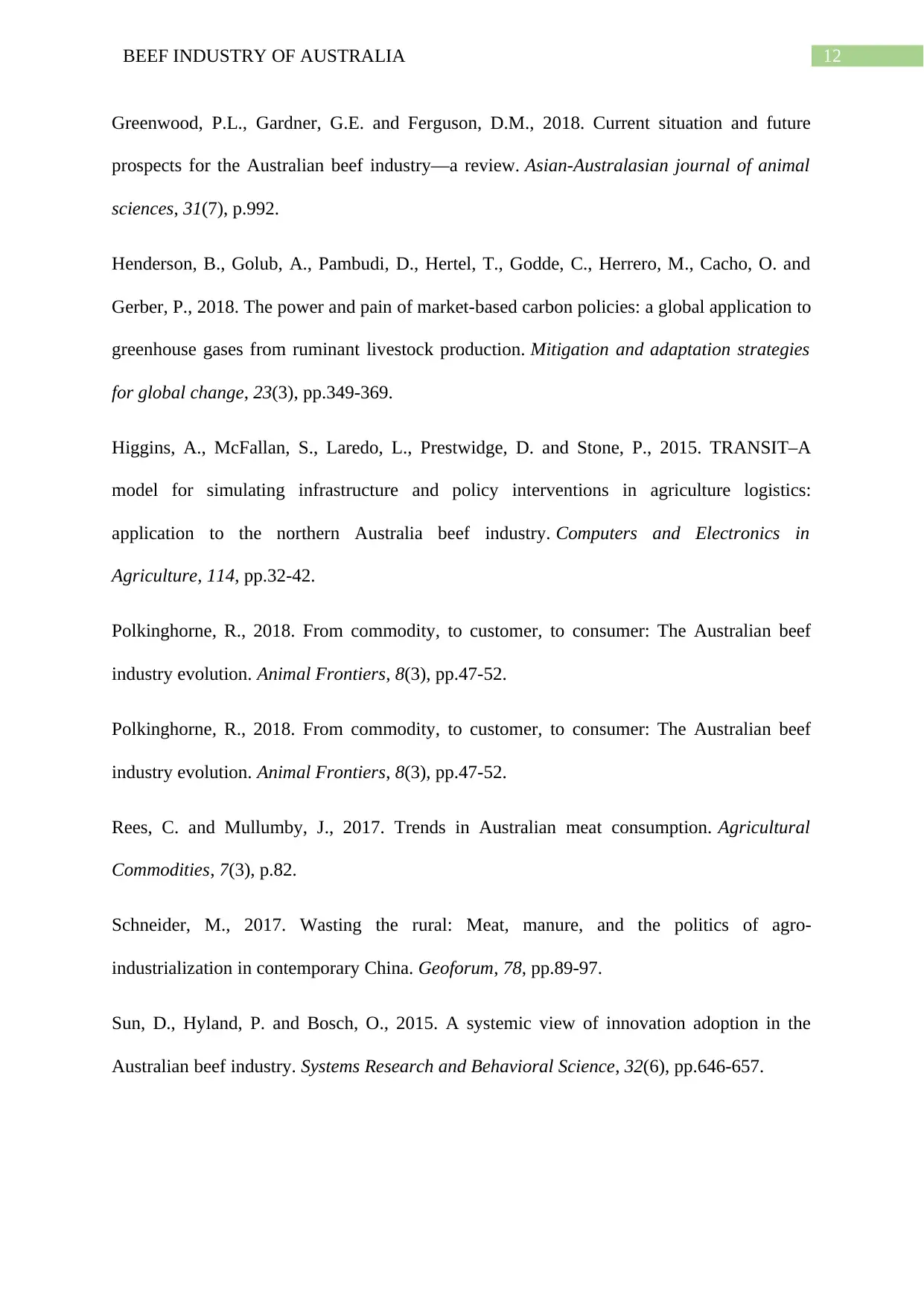
12BEEF INDUSTRY OF AUSTRALIA
Greenwood, P.L., Gardner, G.E. and Ferguson, D.M., 2018. Current situation and future
prospects for the Australian beef industry—a review. Asian-Australasian journal of animal
sciences, 31(7), p.992.
Henderson, B., Golub, A., Pambudi, D., Hertel, T., Godde, C., Herrero, M., Cacho, O. and
Gerber, P., 2018. The power and pain of market-based carbon policies: a global application to
greenhouse gases from ruminant livestock production. Mitigation and adaptation strategies
for global change, 23(3), pp.349-369.
Higgins, A., McFallan, S., Laredo, L., Prestwidge, D. and Stone, P., 2015. TRANSIT–A
model for simulating infrastructure and policy interventions in agriculture logistics:
application to the northern Australia beef industry. Computers and Electronics in
Agriculture, 114, pp.32-42.
Polkinghorne, R., 2018. From commodity, to customer, to consumer: The Australian beef
industry evolution. Animal Frontiers, 8(3), pp.47-52.
Polkinghorne, R., 2018. From commodity, to customer, to consumer: The Australian beef
industry evolution. Animal Frontiers, 8(3), pp.47-52.
Rees, C. and Mullumby, J., 2017. Trends in Australian meat consumption. Agricultural
Commodities, 7(3), p.82.
Schneider, M., 2017. Wasting the rural: Meat, manure, and the politics of agro-
industrialization in contemporary China. Geoforum, 78, pp.89-97.
Sun, D., Hyland, P. and Bosch, O., 2015. A systemic view of innovation adoption in the
Australian beef industry. Systems Research and Behavioral Science, 32(6), pp.646-657.
Greenwood, P.L., Gardner, G.E. and Ferguson, D.M., 2018. Current situation and future
prospects for the Australian beef industry—a review. Asian-Australasian journal of animal
sciences, 31(7), p.992.
Henderson, B., Golub, A., Pambudi, D., Hertel, T., Godde, C., Herrero, M., Cacho, O. and
Gerber, P., 2018. The power and pain of market-based carbon policies: a global application to
greenhouse gases from ruminant livestock production. Mitigation and adaptation strategies
for global change, 23(3), pp.349-369.
Higgins, A., McFallan, S., Laredo, L., Prestwidge, D. and Stone, P., 2015. TRANSIT–A
model for simulating infrastructure and policy interventions in agriculture logistics:
application to the northern Australia beef industry. Computers and Electronics in
Agriculture, 114, pp.32-42.
Polkinghorne, R., 2018. From commodity, to customer, to consumer: The Australian beef
industry evolution. Animal Frontiers, 8(3), pp.47-52.
Polkinghorne, R., 2018. From commodity, to customer, to consumer: The Australian beef
industry evolution. Animal Frontiers, 8(3), pp.47-52.
Rees, C. and Mullumby, J., 2017. Trends in Australian meat consumption. Agricultural
Commodities, 7(3), p.82.
Schneider, M., 2017. Wasting the rural: Meat, manure, and the politics of agro-
industrialization in contemporary China. Geoforum, 78, pp.89-97.
Sun, D., Hyland, P. and Bosch, O., 2015. A systemic view of innovation adoption in the
Australian beef industry. Systems Research and Behavioral Science, 32(6), pp.646-657.
Paraphrase This Document
Need a fresh take? Get an instant paraphrase of this document with our AI Paraphraser
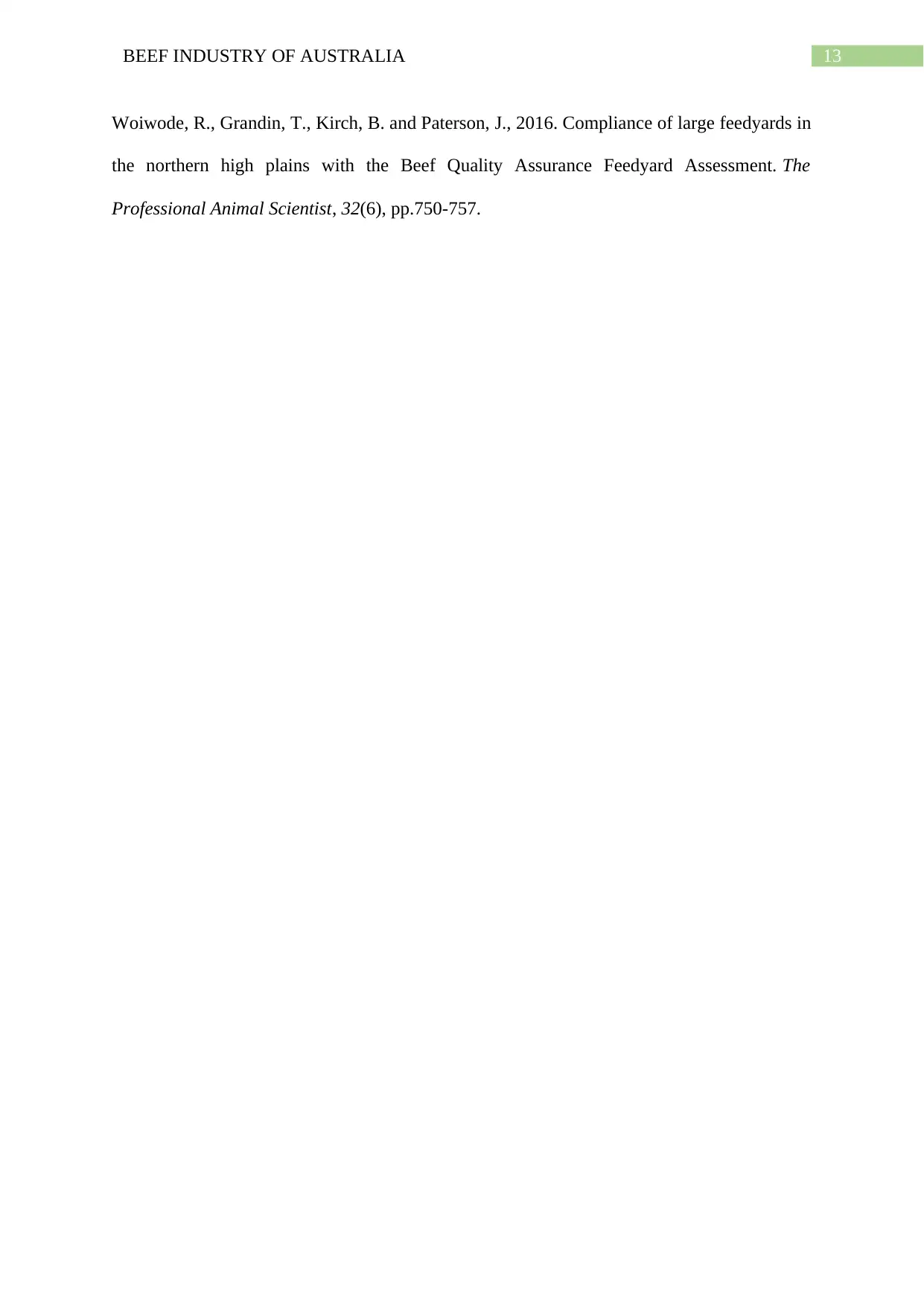
13BEEF INDUSTRY OF AUSTRALIA
Woiwode, R., Grandin, T., Kirch, B. and Paterson, J., 2016. Compliance of large feedyards in
the northern high plains with the Beef Quality Assurance Feedyard Assessment. The
Professional Animal Scientist, 32(6), pp.750-757.
Woiwode, R., Grandin, T., Kirch, B. and Paterson, J., 2016. Compliance of large feedyards in
the northern high plains with the Beef Quality Assurance Feedyard Assessment. The
Professional Animal Scientist, 32(6), pp.750-757.
1 out of 14
Related Documents
Your All-in-One AI-Powered Toolkit for Academic Success.
+13062052269
info@desklib.com
Available 24*7 on WhatsApp / Email
![[object Object]](/_next/static/media/star-bottom.7253800d.svg)
Unlock your academic potential
© 2024 | Zucol Services PVT LTD | All rights reserved.





